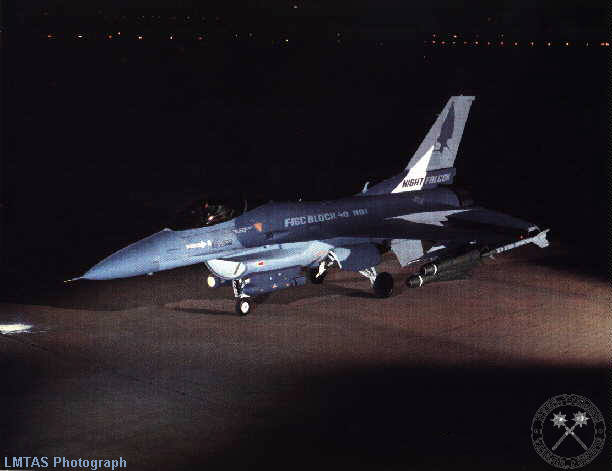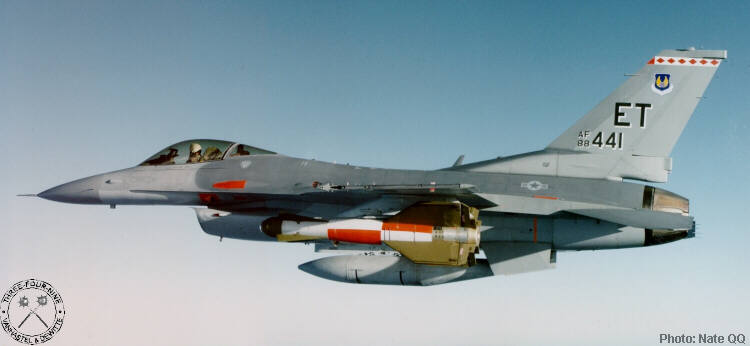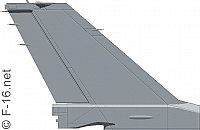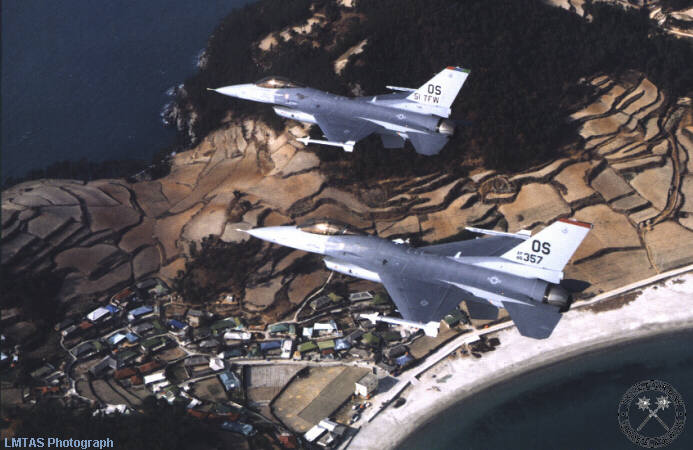History
The next major production block (Block 40/42), sometimes known as the "Night Falcon" because of its enhanced night/all-weather capabilities, appeared in 1989. It was unofficially designated F-16CG/DG when the USAF wanted to call the LANTIRN capable Viper an F-16G, but Congress wouldn't approve a "new" aircraft, which was politically seen as a threat to the F-22.

The first Block 40/42 F-16 rolled out of the Fort Worth facility in December 1988, and was delivered during the same month. Production ended temporarily in 1995, and will restart again in 1999 to build a 21-aircraft order for Egypt.
Block 40/42 (also part of MSIP III) introduced the LANTIRN navigation and targeting pods and the associated holographic HUD, the GPS (Global Positioning System) navigation receiver, APG-68V(5) radar (with a 100+ hour Mean Time Between Failures or MTBF) and ALE-47 decoy launchers, digital flight controls (replacing the old analog ones), automatic terrain following, and a diffractive optics heads-up display. Also included were a new positive-pressure breathing system to improve G-tolerance for the pilot, full provisions for internal electronic countermeasures, an enhanced envelope gun sight, and a capability for bombing moving ground targets.
Structure & Avionics
The configured engine bay has options for either the General Electric F110-GE-100 (Block 40) or the Pratt & Whitney F100-PW-220 (block 42), although the two engines are not routinely interchangeable. The airframe was provided with greater structural strength, which raised the 9G capability from 26,900 pounds to 28,500 pounds. Maximum take-off weight was increased to 42,300lbs (19,187kg).
The undercarriage legs were made longer in order to provide more adequate clearance for the two underfuselage LANTIRN pods, and were beefed up to handle the increased weight. The aircraft also has bulged landing gear doors to accommodate the larger wheels and tires, and the landing lights were moved to the nose gear doors.
Modifications & Upgrades
The Martin-Marietta LANTIRN (Low-Altitude Navigation and Targeting Infra-Red for Night) system consists of two separate pods, each mounted underneath the air intake. The AAQ-13 navigation pod is on the left, the AAQ-14 targeting pod is on the right. The navigation pod has terrain-following radar and FLIR, whereas the targeting pod has FLIR and a laser designator. The LANTIRN must interface with the flight controls, since the pod flies the airplane while in terrain-following mode.
The F-16C/D Block 40/42 aircraft were initially fitted with only the navigation pod, since the targeting pod was delayed by technical difficulties.

Provisions for the Texas Instruments (now part of Raytheon) AGM-88 HARM II were added in 1989. The precision weapons incorporated by the Block 40/42 include the GBU-10, GBU-12, GBU-24 Paveway family of laser-guided bombs as well as the GBU-15 glide bomb. Some foreign versions of the aircraft can carry the AIM-7 Sparrow missile.
Sure Strike
In 1995, 38 F-16C/D Block 40 aircraft of USAFE's 31st Fighter Wing based at Aviano AB, Italy, were equipped with Sure Strike. This package consists of Night Vision Goggles (NVG) and an Improved Data Modem (IDM), giving the aircraft quick reaction capability for CAS missions over Bosnia.
The IDM (now standard on the Block 50/52 and MLU aircraft) allows the aircraft to receive latitude, longitude and elevation of a target direct from a FAC (Forward Air Controller) on the ground. The system then inputs the data into the weapon system computer and displays it as a waypoint on the HUD.
Made up entirely from off-the shelf components, it took just 13 weeks to field Sure Strike. The success of the program led to the USAF ordering that Sure Strike software is to be included in conjunction with a rapid release software update recently requested by USAF to improve the weapon-to-aircraft interface of the AIM-120 Advanced Medium Range Air-to-Air Missile (AMRAAM). This action ensures that Sure Strike capability will be included in the major software upgrade (Block 40 tape five) for the close air support update planned in June 1998.
Gold Strike
In July 1997, Lockheed Martin was awarded a contract to upgrade the Sure Strike system under a project called Gold Strike. Gold Strike basically adds two-way imagery transmission to Sure Strike, enabling the pilot to receive and transmit video images in the cockpit.
Software changes will be made within the core avionics computers to display the video images on the F-16s Multi-Function Display (MFD) and to transmit images from the LANTIRN targeting pod. Upon successful completion of the demonstration, the USAF has the option to incorporate this capability in the Sure Strike-modified Block 40 F-16s at Aviano Air Base in Italy.
Production
Production of the block 40/42 totals 615 airframes. Manufacturing started in 1989 as a successor of the block 30/32 airframe. It ended in the late nineties with a follow-on order from Egypt. Block 40 aircraft were delivered to the USAF, Turkey, Bahrain, Israël and Egypt. Block 42 aircraft were only delivered to the USAF.
Specifications
Engine: One Pratt & Whitney F100-PW-220 turbofan, rated at 14,590 lb.s.t. dry and 23,770 lb.s.t. with afterburning or one General Electric F110-GE-100 turbofan, rated at 17,155 lb.s.t. dry and 28,984 lb.s.t. with afterburning.
Performance: Maximum short-endurance speed: Mach 2.02 (1333 mph) at 40,000 feet. Maximum sustained speed Mach 1.89 (1247 mph) at 40,000 feet. Tactical radius (hi-lo-hi interdiction on internal fuel with six 500-lb bombs) 360 miles. Maximum ferry range 2450 miles with maximum external fuel.
Dimensions: wingspan 31 feet 0 inches, length 49 feet 4 inches, height 16 feet 8 1/2 inches, wing area 300 square feet.
Weights: 18,238 pounds empty, 26,463 pounds normal loaded (air-to-air mission), 42,300 pounds maximum takeoff.
Engine should also include One Pratt @Whitney F100-PW-229 turbofan with 17,800 lb.s.t dry and 29,100 lb.s.t with afterbruning
ANG blk 42s were upgraded with the PW 229 over several years as the aircraft with the PW 220 was always considered underpowered, especially carrying heavy loads at altitude.
This article says the Block 40 landing gear was made longer for LANTIRN pod clearance. That is not correct. The landing gear geometry stayed the same, but the struts were strengthened for the higher gross weight. Making the gear longer would have required changing the size of the landing gear bays. The wheels and tires did get larger with higher pressure tires, resulting in the bumped main landing gear doors. The larger diameter wheels also had larger brake to stop the heavier aircraft
Please use this form to add any list any error or omissions you find in the above text.
Note: your comments will be displayed immediately on this page. If you wish to send a private comment to the webmasters, please use the Contact Us link.


